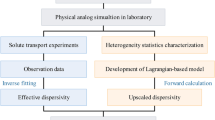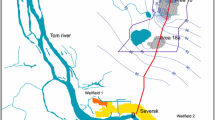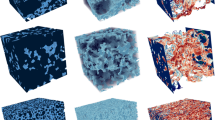Abstract
Solute transport in subsurface environments is controlled by geological heterogeneity over multiple scales. In reactive transport characterized by a low Damköhler number, it is also controlled by the rate of kinetic mass transfer. A theory for addressing the impact of sedimentary texture on the transport of kinetically sorbing solutes in heterogeneous porous formations is derived using the Lagrangian-based stochastic methodology. The resulting model represents the hierarchical organization of sedimentary textures and associated modes of log conductivity (K) for sedimentary units through a hierarchical Markov Chain. The model characterizes kinetic sorption using a spatially uniform linear reversible rate expression. Our main interest is to investigate the effect of sorption kinetics relative to the effects of K heterogeneity on the dispersion of a reactive plume. We study the contribution of each scale of stratal architecture to the dispersion of kinetically sorbing solutes in the case of a low Damköhler number. Examples are used to demonstrate the time evolution and relative contributions of the auto- and cross-transition probability terms to dispersion. Our analysis is focused on the model sensitivity to the parameters defined at each hierarchical level (scale) including the integral scales of K spatial correlation, the anisotropy ratio, the indicator correlation scales, and the contrast in mean K between facies defined at different scales. The results show that the anisotropy ratio and integral scales of K have negligible effect upon the longitudinal dispersion of sorbing solutes. Furthermore, dispersion of sorbing solutes depends mostly on indicator correlation scales, and the contrast of the mean conductivity between units at different scales.









Similar content being viewed by others
References
Allen-King RM, Halket RM, Gaylord DR, Robin MJL (1998) Characterizing the heterogeneity and correlation of perchloroethene sorption and hydraulic conductivity using a facies-based approach. Water Resour Res 34:385–396. doi:10.1029/97wr03496
Allen-King RM, Divine DP, Robin MJL, Alldredge JR, Gaylord DR (2006) Spatial distributions of perchloroethylene reactive transport parameters in the Borden Aquifer. Water Resour Res 42:W01413. doi:10.1029/2005WR003977
Attinger S, Dentz M, Kinzelbach H, Kinzelbach W (1999) Temporal behaviour of a solute cloud in a chemically heterogeneous porous medium. J Fluid Mech 386:77–104
Attinger S, Dentz M, Kinzelbach W (2004) Exact transverse macro dispersion coefficients for transport in heterogeneous porous media. Stoch Environ Res Risk Assess 18(1):9–15
Bellin A, Valocchi AJ, Rinaldo A (1991) Double peak formation in reactive solute transport in one-dimensional heterogeneous porous media. Quaderni del Dipatimento IDR 1/1991, Dipartimento di Ingegneria Civile et Ambientale, Universita degli Studdi Trento
Bellin A, Lawrence AE, Rubin Y (2004) Models of sub-grid variability in numerical simulations of solute transport in heterogeneous porous formations: three-dimensional flow and effect of pore-scale dispersion. Stoch Environ Res Risk Assess 18(1):31–38
Cvetkovic V, Dagan G (1994) Transport of kinetically sorbing solute by steady random velocity in heterogeneous porous formations. J Fluid Mech 265:189–215
Dagan G (1982) Stochastic modeling of groundwater flow by unconditional and conditional probabilities 2. The solute transport. Water Resour Res 18(4):0835–0848
Dagan G (1984) Solute transport in heterogeneous porous formations. J Fluid Mech 145:151–177
Dagan G (1988) Time-dependent macrodispersion for solute transport in anisotropic heterogeneous aquifers. Water Resour Res 24(9):1491–1500
Dagan G (1989) Flow and transport in porous formations. Springer, Berlin
Dai Z, Ritzi RW Jr, Huang C, Rubin YN, Dominic DF (2004) Transport in heterogeneous sediments with multimodal conductivity and hierarchical organization across scales. J Hydrol 294(1):68–86
Dai Z, Ritzi RW Jr, Dominic DF (2005) Improving permeability semivariograms with transition probability models of hierarchical sedimentary architecture derived from outcrop analog studies. Water Resour Res 41:W07032. doi:10.1029/2004WR003515
Dai Z, Wolfsberg A, Lu Z, Deng H (2009) Scale dependence of sorption coefficients for contaminant transport in saturated fractured rock. Geophys Res Lett 36:L01403. doi:10.1029/2008GL036516
de Marsily G (1986) Quantitative hydrogeology. Academic Press, Orlando
Deng H, Dai Z, Wolfsberg A, Lu Z, Ye M, Reimus P (2010) Upscaling of reactive mass transport in fractured rocks with multimodal reactive mineral facies. Water Resour Res 46:W06501. doi:10.1029/2009WR008363
Deng H, Dai Z, Wolfsberg AV, Ye M, Stauffer PH, Lu Z, Kwicklis E (2013) Upscaling retardation factor in hierarchical porous media with multimodal reactive mineral facies. Chemosphere 91(3):248–257
Fernàndez-Garcia D, Illangasekare TH, Rajaram H (2005) Differences in the scale dependence of dispersivity and retardation factors estimated from forced-gradient and uniform flow tracer tests in three-dimensional physically and chemically heterogeneous porous media. Water Resour Res 41:W03012. doi: 10.1029/2004WR003125
Frind EO, Sudicky EA, Schellenberg SL (1987) Micro-scale modelling in the study of plume evolution in heterogeneous media. Stoch Hydrol Hydraul 1(4):263–279
Guin A, Ramanathan R, Ritzi RW Jr, Dominic DF, Lunt IA, Scheibe TD, Freedman VL (2010) Simulating the heterogeneity in braided channel belt deposits: 2. Examples of results and comparison to natural deposits. Water Resour Res 46:W04516. doi:10.1029/2009WR008112
Keller R, Giddings J (1960) Multiple zones and spots in chromatography. J Chromatogr 3:205–220
Maghrebi M, Jankovic I, Fiori A, Dagan G (2013) Effective retardation factor for transport of reactive solutes in highly heterogeneous porous formations. Water Resour Res 49(12). doi: 10.1002/2013WR014429
Massabó M, Bellin A, Valocchi AJ (2008) Spatial moments analysis of kinetically sorbing solutes in aquifer with bimodal permeability distribution. Water Resour Res 44:W09424. doi:10.1029/2007WR006539
Parker JC, Valocchi AJ (1986) Constraints on the validity of equilibrium and first-order kinetic transport models in structured soils. Water Resour Res 22(3):399–407
Quinodoz HAM (1992) Transport of kinetically adsorbing contaminants in randomly heterogeneous aquifers. Ph.D. thesis, University of Illinois at Urbana-Champaign
Quinodoz HAM, Valocchi AJ (1993) Stochastic analysis of the transport of kinetically adsorbing solutes in aquifers with randomly heterogeneous hydraulic conductivity. Water Resour Res 29(9):3227–3240
Rajaram H (1997) Time and scale dependent effective retardation factors in heterogeneous aquifers. Adv Water Resour 20(4):217–230
Ramanathan R, Ritzi RW Jr, Huang C (2008) Linking hierarchical stratal architecture to plume spreading in a Lagrangian-based transport model. Water Resour Res 44(4). doi:10.1029/2009WR007810
Ramanathan R, Ritzi RW Jr, Allen-King RM (2010) Linking hierarchical stratal architecture to plume spreading in a Lagrangian-based transport model: 2. Evaluation using new data from the Borden site. Water Resour Res 46:W01510. doi:10.1029/2009WR007810
Ritzi RW Jr (2000) Behavior of indicator variograms and transition probabilities in relation to the variance in lengths of hydrofacies. Water Resour Res 36(11):3375–3381. doi:10.1029/2000WR900139
Ritzi RW, Allen-King RM (2007) Why did Sudicky [1986] find an exponential-like spatial correlation structure for hydraulic conductivity at the Borden research site? Water Resour Res 43:W01406. doi:10.1029/2006WR004935
Ritzi RW, Dai Z, Dominic DF, Rubin Y (2002) Spatial structure of permeability in relation to hierarchical sedimentary architecture in buried-valley aquifers: centimeter to kilometer scales. In: Findikakis A (ed) Bridging the gap between measurements and modeling in heterogeneous media. IAHS and Lawrence Berkeley Laboratory, (on CD-ROM)
Ritzi RW, Dai Z, Dominic DF, Rubin YN (2004) Spatial correlation of permeability in crossstratified sediment with hierarchical architecture. Water Resour Res 40(3):W03513. doi:10.1029/2003WR002420
Ritzi RW Jr, Huang L, Ramanathan R, Allen-King RM (2013) Horizontal spatial correlation of hydraulic and reactive transport parameters as related to hierarchical sedimentary architecture at the Borden research site. Water Resour Res 49:1901–1913. doi:10.1002/wrcr.20165
Rubin Y (1995) Flow and transport in bimodal heterogeneous formations. Water Resour Res 31(10):1468–2461
Rubin Y (2003) Applied stochastic hydrogeology. Oxford University Press, Oxford
Rubin Y, Lunt IA, Bridge JS (2006) Spatial variability in river sediments and its link with river channel geometry. Water Resour Res 42:W06D16. doi:10.1029/2005WR004853
Rubin Y, Cushey MA, Bellin A (1994) Modeling of transport in groundwater for environmental risk assessment. Stoch Hydrol Hydraul 8(1):57–77
Sardin M, Schweich D, Leij FJ, Genuchten MT (1991) Modeling the nonequilibrium transport of linearly interacting solutes in porous media: a review. Water Resour Res 27(9):2287–2307
Scheibe TD, Freyberg DL (1995) The use of sedimentological information for geometric simulation of natural porous media structure. Water Resour Res 31:3259–3270
van Genuchten MT (1985) A general approach for modeling solute transport in structured soils. Mem Int Assoc Hydrogeol 17(1):513–526
White CD, Willis BJ (2000) A method to estimate length distributions from outcrop data. Math Geol 32:389–419. doi:10.1023/A:100751061505
Acknowledgments
The first author was supported by the National Science Foundation under grant EAR-0810151, and also by a Graduate Fellowship from the college of science and mathematics at Wright State University. Any opinions, findings and conclusions or recommendations expressed in this article are those of the authors and do not necessarily reflect those of the National Science Foundation or other supporting institutions. We gratefully acknowledge the time and expertise given by three anonymous reviewers and the associate editor. Their constructive comments and suggestions helped us to improve the article.
Author information
Authors and Affiliations
Corresponding author
Appendices
Appendix 1: Derivation of spectral density of fluctuations in ln(K)
Considering an exponential covariance function of ln(K) (Dagan 1989; Rubin 2003):
where μ i are the integral scales. The Fourier transform of ln(K) is found by:
Substituting (33) into (34) yields:
Integrating (35) leads to the following expression for the Fourier transform of ln(K):
where \( (\mu k)^{2} = (\mu_{1} k_{1})^{2} + (\mu_{2} k_{2})^{2} + (\mu_{3} k_{3})^{2} \). (36) is the Fourier transform of ln(K) for the unimodal porous media. For the multimodal porous media, the multimodal covariance function of ln(K) (Eq. (8) and/or Eq. (9)) is easily integrated to obtain the corresponding Fourier transform of ln(K).
Appendix 2: Derivation of the dispersivity of nonreactive solute
Here we use the integration method suggested by Dagan (1989) to derive the related expression for the dispersivity of a nonreactive solute. Equation (15) contains the following integral:
where u pq is the flow velocity covariance. The Fourier transform of flow velocity, Eq. (14), is used to evaluate (37). By using (36) we get the Fourier transform of flow velocity in the longitudinal direction as:
Therefore,
Hence,
Changing variables \( s^{\prime} = \mu^{- 1}_{1} \,\,U\,s \) and τ = Ut/μ 1 gives
Now we use \( \mu_{1} \, = \mu_{2} = \lambda \) and μ 3 = ɛλ in which ɛ is the anisotropy ratio. Thus,
Now changing to spherical coordinate system and defining:
Therefore,
In order to derive the above integral the following general integrals are used;
To evaluate the integral in (38) the following parameters are used in (39a)–(c):
Thus, one can derive (38) as follows
where
The J o and J 1 are the zero and first order Bessel functions, respectively. By changing the variable β = rτ the integration in (40) yields
In the above integral one can use the following general integral
Finally, α (nr)11 (t) is found as follows
where
Appendix 3: Statistical moments of t m
The first two temporal moments of t m are given by the following expressions (Quinodoz and Valocchi 1993; Massabó et al. 2008):
where p(t m ) is the pdf of t m given by the expression (22), \( R_{d} = 1 + K_{d} \), and \( \Upsilon = k_{r} \,R_{d} \,t \).
Rights and permissions
About this article
Cite this article
Soltanian, M.R., Ritzi, R., Dai, Z. et al. Transport of kinetically sorbing solutes in heterogeneous sediments with multimodal conductivity and hierarchical organization across scales. Stoch Environ Res Risk Assess 29, 709–726 (2015). https://doi.org/10.1007/s00477-014-0922-3
Published:
Issue Date:
DOI: https://doi.org/10.1007/s00477-014-0922-3




